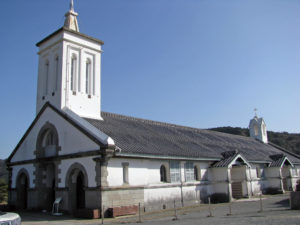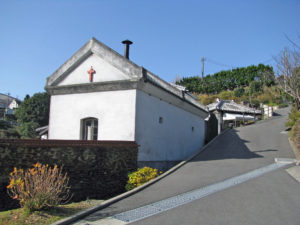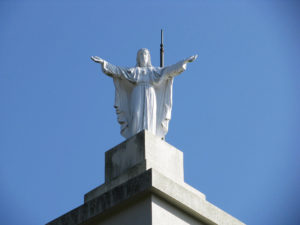Christian Pilgrimage sites in Nagasaki Region
This Tourist information is created by Japan KYUSHU Tourist for enjoyment
of your travel. We are the Travel Agent in Fukuoka specializing in Kyushu.
When you have an idea or a plan for traveling in Kyushu, Japan, please contact
us by sending an Enquiry. Make an Enquiry
Hidden Christian site is registered on UNESCO’s World Heritage. Japanese Christianity has
a unique history of continuing faith while coexisting with Japanese traditional religion Shinto and
General society. Japan’s unique practice of the Christian faith continued even during the ban
on Christianity. Hidden Christian Site in Nagasaki, Shimabara , Hirado and Amakusa Regions
bear unique testimony to the tradition of people and their communities who secretly transmitted
their faith in Christianity while surviving in the midst of the conventional society and its religions
during the time of prohibition.
Oura Cathedral / UNESCO World Heritage
Basilica of Martyrdom of the 26 Saints of Japan. Built in 1865 under the supervision of the French
priest Bernard Petitjean. It was designated as a National Treasure in 1933 for its value as Japan’s
oldest Gothic-style Cathedral.
Martyrdom of the 26 Saints of Japan
Sotome area Hidden Christian Site / UNESCO World Heritage
Sotome is located between Nagasaki-city and Saikai-city, and face to East China Sea.
During the ban on Christianity from 17 century to end of the 19 century, Sotome was
home to communities of “Hidden Christians”, many of whom emigrated there from
other parts of Nagasaki as the remote region allowed them to practice their religion
in secret. French missionary Father Marc Marie de Rotz played a large role in
reestablishing the religion in the area. He established Shitsu Church on a hill
overlooking the sea.
Originally constructed in 1895 as a brick Romanesque building, after a long-standing ban on
Christianity was lifted. When completed in 1914, it was the largest Catholic church in East Asia.
The atomic bomb dropped on August 9, 1945 explored in Urakami, only 500m from the cathedral,
which was completely destroyed. What remained of the cathedral is now on display in the
Atomic Bomb Museum.
Hara Castle Ruins / UNESCO World Heritage
The Battle field of Shimabara Rebellion which was a peasant uprising agaist bakufu’s persecution
of Christians under the leadership of Amakusa Shiro in 1637. Christian farmers rose in a riot due
to their grievance about the oppression by Matsukura Shigemasa. The Shogunate regarded this
riot as Christian rebellion and sent its punitive force, therefore locked themselves in the castle and
with their leader Amakusa Shiro Tokisada fought against the Shogunate. On February 27, 1638,
he died in battle. The following day, the castle fell. 37,000 Christians including women and children
died a violent death.
Hory Mary-Kannon of Hara Castle, in Minami-Shimabara
The world’s tallest wooden Holy Mary statue, with 10 meters in height.
This statue was made by sculptor Oyamatsu Eiji over a period of 40 years and was completed
when he was 90 years old.
The statue is located in Minami-Shimabara-city, 10 minutes drive from Hara Castle Ruins,
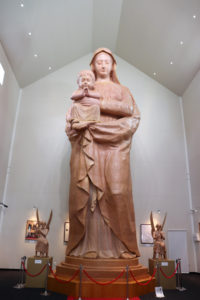 |
 |
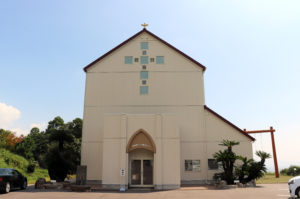 |
Jigoku, means Hell, is the number one attraction of Unzen with a peculiar smell of sulfur emitted
from the springs, and with white smoke rising from the ground over a wide area.
Unfortunately, this was once put into reality nearly 350 years ago during the time of religious
persecution in Japan. 30 Japanese Christians, failing to renounce their faith met their death
here in the scalding spring of Jigoku.
Christianity in Hirado
When the religion was banned in the early Edo Period, and the Christians were forced to give up their
religion, a few believers, known as the “Hidden Christians”, continued to practice their religion in secret
for over two centuries. Some did so in the remote villages of Hirado Island.
In the late 1800s, the ban on Christianity was lifted, and many of the Hidden Christians rejoined the
Catholic Church and built new churches with the assistance of foreign priests. A few also refrained from
rejoining because their religious practices evolved quite a bit over the centuries to a degree where they
were not compatible with Catholicism anymore.
Nakae no Shima / UNESCO World Heritage
Located two kilometers off the coast of Hirado Island, Nakae no Shima is a small, uninhabited island
where religious leaders were executed during the persecution of Christians. The island is considered
sacred, and water collected there is used for baptism.
 |
 |
 |
Kasuga Village / UNESCO World Heritage
This idyllic, remote village was refuge to a small community of Hidden Christians who practiced here
for centuries, far from the prying eyes of the government. After the ban on Christianity was lifted, the
local villagers decided to continue practicing their own unique brand of the religion rather than rejoin
the Catholic Church. As a result, churches were not erected in the village, and the religion remains
outwardly invisible.
 |
 |
 |
Kurose no Tsuji, martyrdom site of Gaspar Nishi Genka
The site where Christian Gaspar Nishi Genka was martyred in 1609, located on
Kurose Hill overlooking Nakae no shima between Hirado and Ikitsuki.
The tomb facing the sea is called Gaspar-sama and is a revered place for Ikitsuki’s
Hidden Christians.
The cross-shaped “Kurose no Tsuji Martyrdom Monument” was erected by Catholics
in 1991, and Mass is held every year around November 14th.
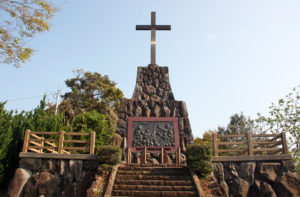 |
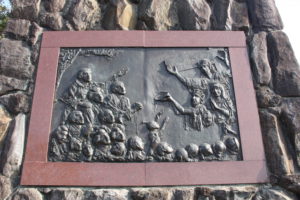 |
 |
The church was designed by Tetsukawa Yosuke, a famous architect of various churches in
Nagasaki-prefecture, and built between December 1915 and October 1917. It is one of the latest
brick churches in the prefecture of Nagasaki. Tetsukawa Yosuke has called this one of his best works.
 |
 |
 |
Hidden Christian of Amakusa
Christianity was first brought to Japan in 1549 by a Jesuit priest named Francis Xavier when trading
opened in Kagoshima. Not long after, it spread to neighboring areas such as Nagasaki and Amakusa.
In 1614, the Tokugawa regime felt threatened by the growth of Christianity out of their fear of
colonialism. Persecutions began and the eradication of Christianity started. Missionaries and priests
alike were killed, while those who practiced Christianity were given an option to renounce their faith or
face death. Some chose to convert to Shintoism and Buddhism in order to hide their Christian faith.
Fed up with famine and cruel treatment, peasants from Amakusa organized a rebellion to fight against
the regime. This resulted in the Shimbara Rebellion, which is considered as one of the largest revolts
during the Edo period.
The oldest Catholic Church in Amakusa and was one of the first churches built right after the ban
on Christianity was lifted. The and Romanesque-style architecture and the chalky white structure
was rebuilt in 1933 by a French missionary priest named Father Garnier using his own money and
contributions from local Christians living in the area.
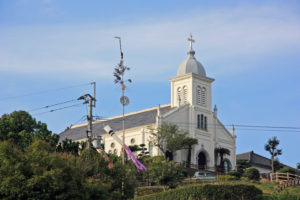 |
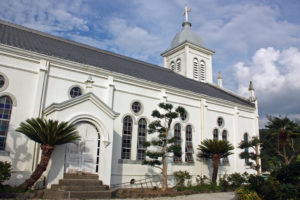 |
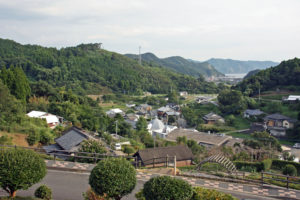 |
Sakitsu Village / UNESCO World Heritage
A Gothic-looking church is located on a cove of a fishing village. In 1934, a French priest Augustin
Halbout MEP purchased the premises of the former village headman and built a wooden and
concrete finished church, with Tetsukawa Yosuke’s design and construction. He placed the altar
at the very site where fumie or a test to ensure non-allegiance to Christianity had been conducted.
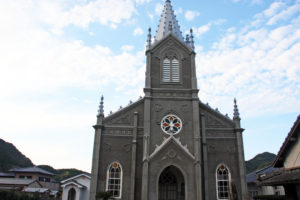 |
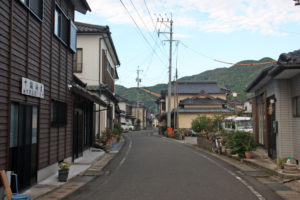 |
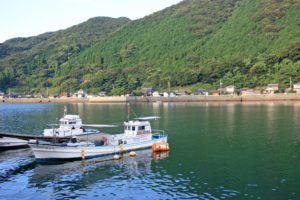 |
The theme Museum shows History of Christianity in Amakusa and Shimabara Rebellion
which was a peasant uprising against bakufu’s persecution of Christians under the leadership
of Amakusa Shiro in 1637.
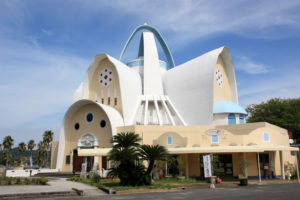 |
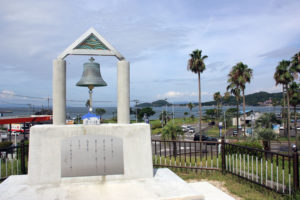 |
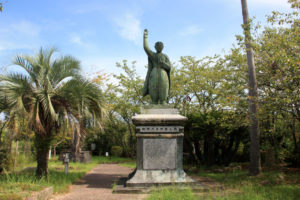 |







